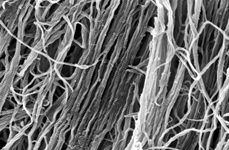 The reason tendons and ligaments do not stretch (very much) is that they are made up predominantly of collagen. Collagen is a ubiquitous and amazing substance found throughout our bodies. It is made up of a protein, the most abundant one in our body. What makes this protein so useful are its strength and resistance to stretching. Unlike most proteins, which form clumps when gathered together, collagen is fibrous and can form mats, sheets, or chord-like structures.
The reason tendons and ligaments do not stretch (very much) is that they are made up predominantly of collagen. Collagen is a ubiquitous and amazing substance found throughout our bodies. It is made up of a protein, the most abundant one in our body. What makes this protein so useful are its strength and resistance to stretching. Unlike most proteins, which form clumps when gathered together, collagen is fibrous and can form mats, sheets, or chord-like structures.
Collagen is what makes our teeth strong, yet it gives our skin its elasticity and strength. When it degrades it creates wrinkles. The word itself comes from the Greek language and means “glue producer.” That gives us a sense of what it does for us it helps hold us together.
Of the twenty-seven of types of collagen, it is the Type 1 collagen that is of the most interest for this exploration. Type 1 collagen is found in our skin, bones, ligaments, and tendons. It is found in the scar tissue that is present after healing. It was collagen that plastic surgeons used to use to enhance the lips of women looking for something better than what Mother Nature provided.
Like the general structure of all tissues in our body, connective tissue has substructures that follow the tubes-within-tubes model. For example, a tendon has bundles within it called “fascicles,” and within these are found fibrils. Within fibrils are subfibrils, and then microfibrils. These in turn are made up of collagen molecules that are composed of chains and cross-links. These cross-links are one of the reasons that collagen is so strong. The more cross-links there are, the stronger the net is. These cross-links are like welds joining together the individual strands in a rope, making them stronger. Of course, the stronger the rope, the less flexible it will be.
Collagen is continually being laid down and absorbed by the body. Cells called “fibroblasts” [1] produce collagen. If the rate of production of collagen is faster than the rate of absorption, then more cross-links are created and the fibers are more resistant to stretching, but are stronger. If the opposite occurs, and the rate of absorption is faster than the rate of production, then fewer cross-links are produced and the fiber is more elastic. Researchers [2] speculated that exercise or mobilization can restrict the number of cross-links, thus increasing flexibility while reducing rigidity. Thus we can see how the practice of yoga can make collagen fibers more flexible.
(Next: Collagen in the Bones )
